
The Smith couple is on a mission on drowning prevention and water safety after their son, River, died in an accident in their backyard swimming pool.
According to the Centers for Disease Control and Prevention, drowning is the most common and leading cause of death for children in the United States and the second leading source of unintentional injury death after motor vehicle crashes.
Children ages 1-4 die from drowning more than any other cause of death excluding birth defects, the agency said on its website.
In 2019, the Smith family was outside their house when River, who was 3 years old at the time, slipped through their home pool gate and went into the water. Although he was pulled out of the pool shortly afterward, River had been deprived of oxygen for too long and later died, per Yahoo News .
Shares water safety tips
Earlier this year, the family, who have been outspoken on the issue of water safety since River's death, shared a video posted on Youtube of their youngest son, Maverick, learning how to swim through a method called ISR.
An ISR stands for Infant Swimming Resource but is more known as infant swim rescue and refers to a self-rescue technique that is taught to kids as young as 6 months old. Children are reportedly instructed to survive in water by finding air and even crying to alert someone close to them that they need help.
"Why did we not know that we had the number one killer of children in our backyard from ages 1 to 4 of accidental death? The number one killer was in our own backyard and we didn't know it," Amber told Good Morning America in an interview that aired Friday.
According to the website of ISR, children ages, 6 months to 1 year learn the ISR Self-Rescue skill of rolling onto their backs to float, rest, and breath. They learn to maintain the position until help arrives.
Preventing drowning deaths
Dr. Sarah Denny, a pediatrician, and spokesperson for the American Academy of Pediatrics said that there isn't any scientific research available that focuses on ISR techniques specifically as ISR and similar programs are known before with social media videos showing dramatic clips of children being tossed into swimming pools by themselves.
Denny states that no one size fits all kids, however, some data shows that starting swim lessons between ages 1 and 4 can have a protected effect against drowning but there is no data to support any benefit of ISR, at this time.
The American Academy of Pediatrics suggests that parents enroll children as young as 1 in a swimming lesson, mainly in the wake of the coronavirus pandemic, when many young ones did not receive lessons as they may have in the past due to temporary pool closings, cancellation of lessons, and stay-at-home orders.
According to Denny, research shows that formal swim lessons for children age 1 and older diminish the risk of drowning. Swim lessons are a salient layer of protection to prevent drowning, in addition to pool fencing, close supervision and lifeguards while swimming, life jackets on boats and lakes, and CPR (Cardiopulmonary Resuscitation) training.
According to the latest World Health Organization (WHO) estimation, 236,000 people lost their lives to drowning in 2019, and more than 50% of these deaths occur among those aged under 30 years.
The Smith Couple said that above all, they wanted Maverick to know how to navigate being in the water, formal training that River hadn't received, to prevent another tragedy.
Related Article : Drowning: Leading Cause of Death in Young Children [Useful Tips to Prevent Them From Happening]